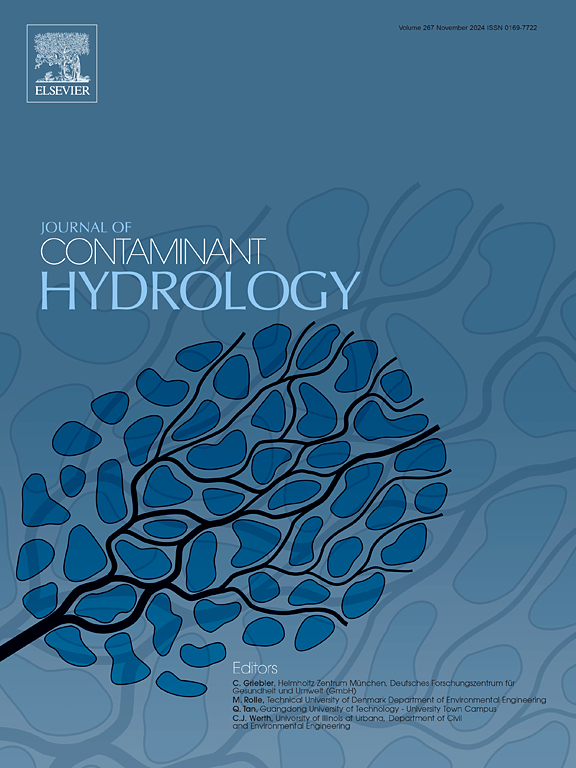Dynamic transformation and leaching processes of nitrogen in a karst agricultural soil under simulated rainfall conditions
IF 3.5
3区 环境科学与生态学
Q2 ENVIRONMENTAL SCIENCES
引用次数: 0
Abstract
Frequent exchange of surface water and groundwater in karst agricultural areas results in soil nutrient loss during rainfall and consequent deterioration of the aquatic environment. To understand nitrogen (N) transformation and leaching processes from karst soil during rainfall events, two typical N fertilizers were added to karst soil and consequently investigated the nitrogenous species using soil column experiments system. The contents of various N forms in the soil and leachate were analyzed, and the net nitrification and the N leaching rates were calculated. The results revealed that NH4+ and NO2− accumulation and variation occurred primarily in shallow soils, indicating that shallow soils were the primary sites for ammonification and nitrification processes. The net nitrification rate in the soil was higher with application of urea (12.5 mg N kg−1d−1) than with manure (2.4 mg N kg−1d−1). Peak N content indicated that it took only 7 days for N to migrate from the topsoil to 90 cm depth of soil after applying urea during successive intense rainfall events. NO3− leaching was predominantly composed of N, followed by DON, with leaching ratios of 31.1 % for the urea column and only 1.7 % for the manure column. These results highlight that the rapid nitrification of urea application coupled with intensive rainfall accelerated nitrate leaching into subterraneous streams in karst hydrological system, supporting a significant contribution from agricultural fertilizer loss during rainfall in karst area.
模拟降雨条件下喀斯特农业土壤氮素动态转化及淋溶过程
喀斯特农业区地表水与地下水频繁交换,导致降雨期间土壤养分流失,导致水环境恶化。为了解降雨过程中喀斯特土壤氮素的转化和淋溶过程,在喀斯特土壤中添加了两种典型氮肥,并利用土壤柱试验系统对氮素种类进行了研究。分析了土壤和渗滤液中各种形态氮的含量,计算了净硝化作用和氮淋滤速率。结果表明,NH4+和NO2-的积累和变化主要发生在浅层土壤,表明浅层土壤是氨化和硝化过程的主要场所。施用尿素(12.5 mg N kg-1d-1)的土壤净硝化速率高于施用有机肥(2.4 mg N kg-1d-1)。峰值氮含量表明,在连续强降雨条件下,施用尿素后,氮素从表层土壤向90 cm土壤深度的迁移仅需7 d。NO3-淋溶以N为主,其次是DON,尿素柱淋溶率为31.1%,粪肥柱淋溶率仅为1.7%。这些结果表明,尿素的快速硝化作用加上强降雨加速了岩溶水文系统中硝酸盐的地下淋滤,支持了降雨期间农业肥料损失的重要贡献。
本文章由计算机程序翻译,如有差异,请以英文原文为准。
求助全文
约1分钟内获得全文
求助全文
来源期刊

Journal of contaminant hydrology
环境科学-地球科学综合
CiteScore
6.80
自引率
2.80%
发文量
129
审稿时长
68 days
期刊介绍:
The Journal of Contaminant Hydrology is an international journal publishing scientific articles pertaining to the contamination of subsurface water resources. Emphasis is placed on investigations of the physical, chemical, and biological processes influencing the behavior and fate of organic and inorganic contaminants in the unsaturated (vadose) and saturated (groundwater) zones, as well as at groundwater-surface water interfaces. The ecological impacts of contaminants transported both from and to aquifers are of interest. Articles on contamination of surface water only, without a link to groundwater, are out of the scope. Broad latitude is allowed in identifying contaminants of interest, and include legacy and emerging pollutants, nutrients, nanoparticles, pathogenic microorganisms (e.g., bacteria, viruses, protozoa), microplastics, and various constituents associated with energy production (e.g., methane, carbon dioxide, hydrogen sulfide).
The journal''s scope embraces a wide range of topics including: experimental investigations of contaminant sorption, diffusion, transformation, volatilization and transport in the surface and subsurface; characterization of soil and aquifer properties only as they influence contaminant behavior; development and testing of mathematical models of contaminant behaviour; innovative techniques for restoration of contaminated sites; development of new tools or techniques for monitoring the extent of soil and groundwater contamination; transformation of contaminants in the hyporheic zone; effects of contaminants traversing the hyporheic zone on surface water and groundwater ecosystems; subsurface carbon sequestration and/or turnover; and migration of fluids associated with energy production into groundwater.
 求助内容:
求助内容: 应助结果提醒方式:
应助结果提醒方式:


